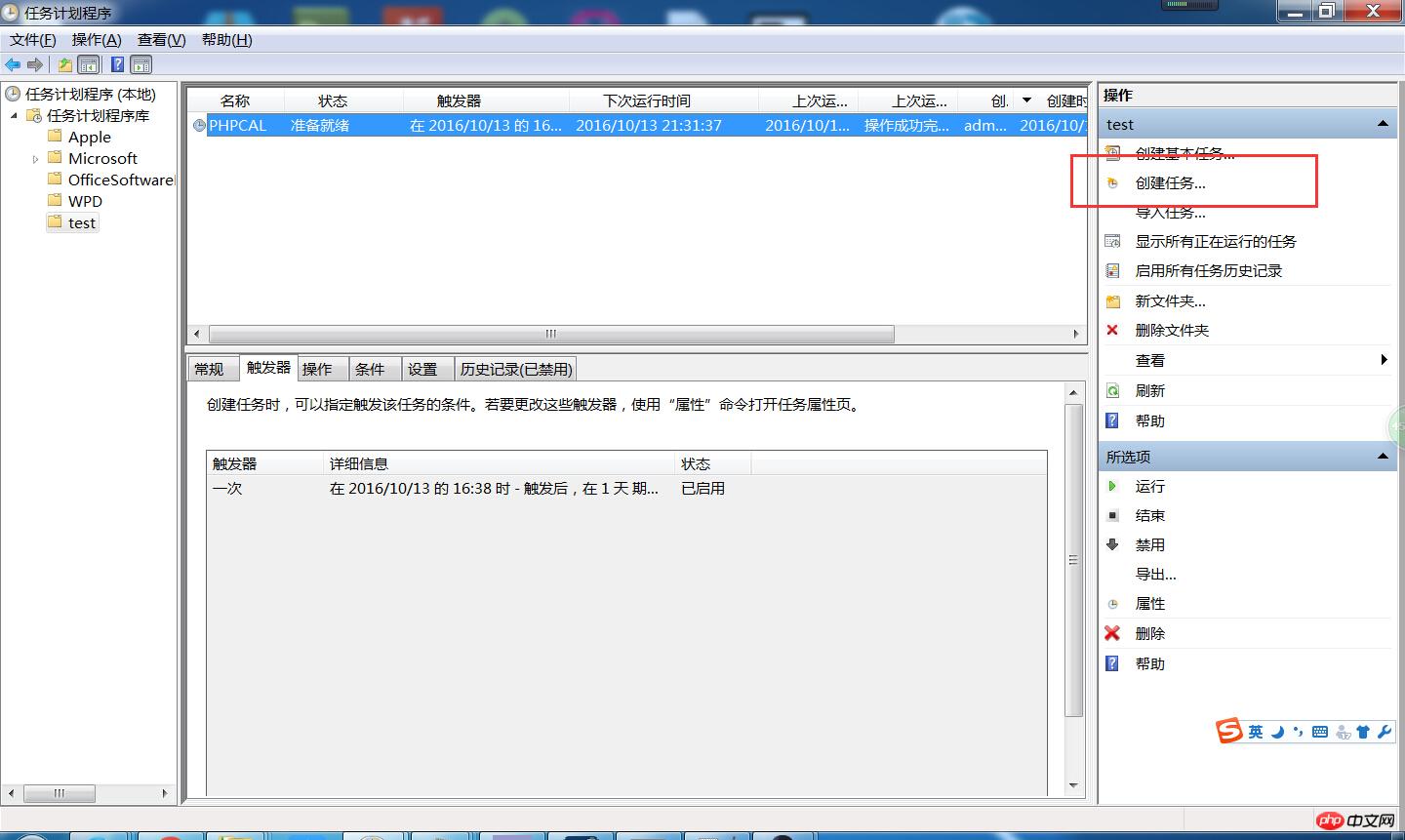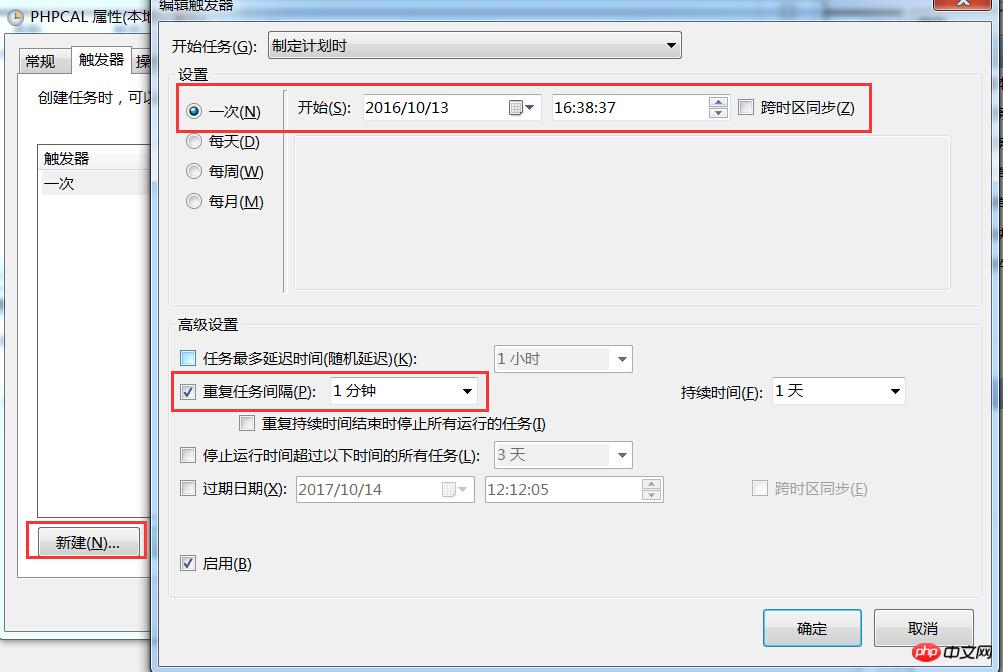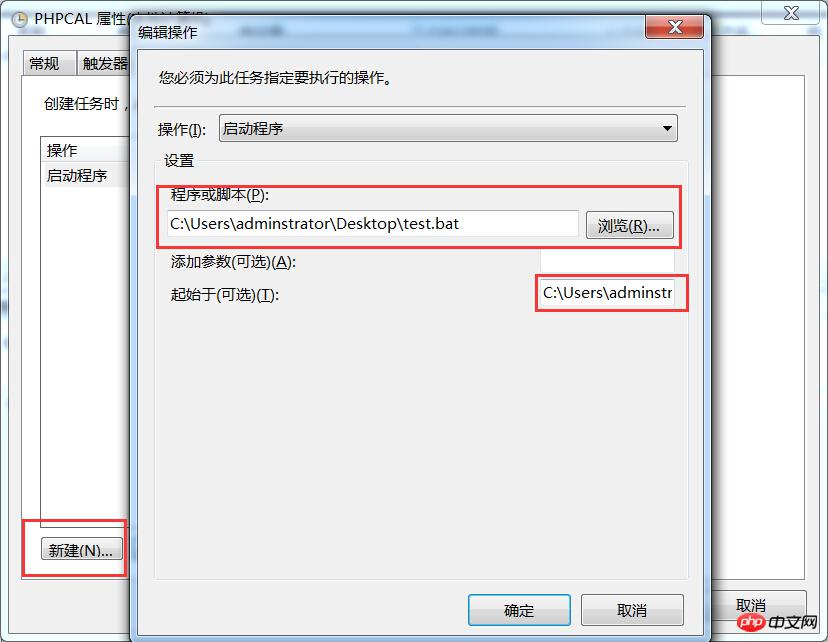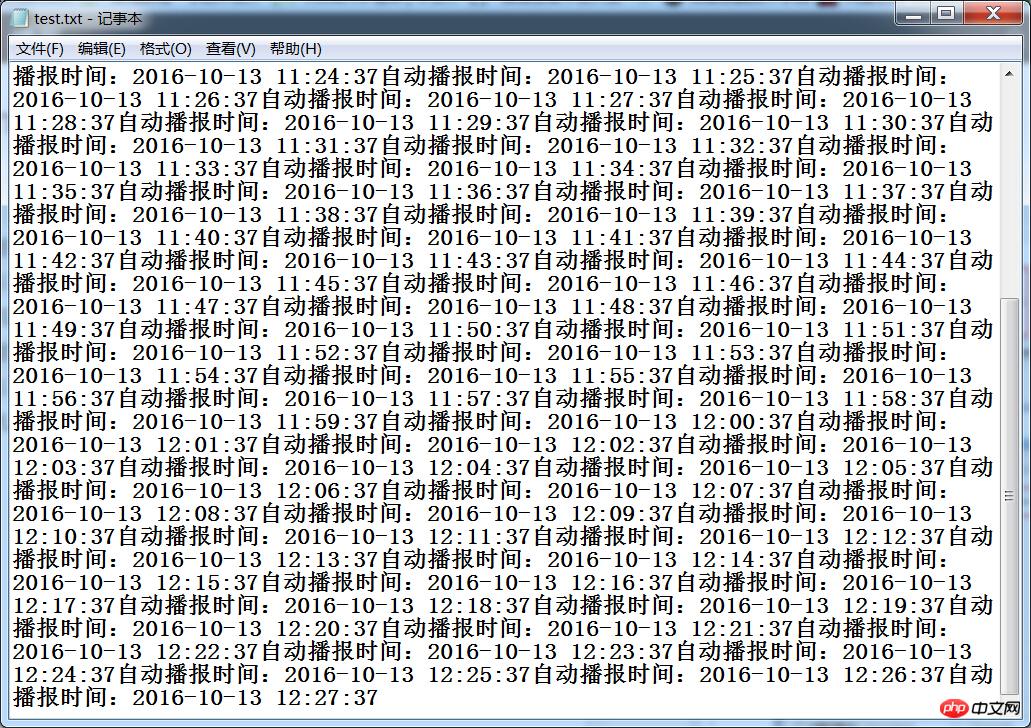 Backend Development
Backend Development
 PHP Tutorial
PHP Tutorial
 PHP implements code and extensions for scheduled execution of Windows tasks (picture)
PHP implements code and extensions for scheduled execution of Windows tasks (picture)
PHP implements code and extensions for scheduled execution of Windows tasks (picture)
Task planning is of great use in our daily work development. Sometimes projects require large batches of data updatesInsert data into the libraryIn order to save resources, we need to automatically perform regular time periods Calculation, for this, we need PHP scheduled tasks to be implemented, so today we will introduce to you PHP to implement scheduled execution of Windows task plans!
In addition, after looking for a solution to this similar problem on the Internet, you can also use PHP's ignore_user_abort() function. This function has not been used yet. The official PHP website introduces it like this
int ignore_user_abort ([ string $value ] )
Set whether to interrupt the execution of the script when the client disconnects. When PHP is executed as a command line script, when the script terminal ends, the script will not be terminated immediately. Unless the value is set to TRUE, otherwise the script will output any characters. was aborted.
My personal understanding is that when executed not through the browser, but through the command line, the code block of this function continues to execute. In this blog post, there is a specific implementation process of this function.
The following is an example for testing.
windows batchProcessing files
Create a new text document, write the following code, and save it as a .bat file.
E: "E:\PHP\wamp\bin\php\php5.5.12\php.exe" -f "E:\PHP\wamp\www\write.php"
PHP operating mode
Usually executing PHP code is executed through the browser requesting the server. This operating mode is called module mode. The module mode is integrated in the form of mod_php5 module. At this time, the function of mod_php5 module is to receive PHP file requests passed by Apache, process these requests, and then return the processed results to Apache. If we configure the PHP module (mod_php5) in its config file before Apache starts, the PHP module registers the ap_hook_post_config hook of apache2 and starts this module when Apache starts to accept requests for PHP files.
When we use php.exe to execute, it is the CLI mode. This blog post explains in detail the four operating modes of PHP.
php.exe
PHP command line execution program php.exe is very powerful. Configure the value of system variablepath under windows environment You can run the php script file directly in the DOS window interface. This article has specific configuration methods.
The php.exe here is one of the three php-related exe files in the php installation directory, php-cgi.exe, php-win.exe
php- cgi.exe is provided for CGI use. It is usually used to parse PHP scripts through CGI in a Windows environment. It is often used to run PHP websites under IIS. The difference is that before all the contents of the file are output, the following will be automatically output. The HTTP header
X-Powered-By: PHP/5.2.5Content-type: text/html
php-win.exe can also execute PHP files. The difference is that the console is opened and the output content is not displayed. It can be used to write file processing, network service and other programs that do not require a display interface.
PHP execution code
<?php$fp = @fopen("E:/PHP/wamp/www/test.txt", "a+");fwrite($fp, "自动播报时间:\n" . date("Y-m-d H:i:s"));fclose($fp);The file path here must be absolute path, because it does not go through a server such as apache or iis, except for some server-based variables that cannot be used , such as $_SERVER, etc., and various unpredictable errors are likely to occur.
Create task plan
Baidu can produce a lot of them at once. I used Windows 7 for testing.
Start-》Accessories-》System Tools-》Task Scheduler
Double-click to create a task
Create a name and set execution permissions
Set the start time and repeat task interval
Select the written script Path
The task scheduler has been created here
The following is the effect of execution
Summary:
I believe many friends know how to use php to implement the execution of windows task plan. I hope it will be helpful to your work!
related suggestion:
The above is the detailed content of PHP implements code and extensions for scheduled execution of Windows tasks (picture). For more information, please follow other related articles on the PHP Chinese website!

Hot AI Tools

Undresser.AI Undress
AI-powered app for creating realistic nude photos

AI Clothes Remover
Online AI tool for removing clothes from photos.

Undress AI Tool
Undress images for free

Clothoff.io
AI clothes remover

AI Hentai Generator
Generate AI Hentai for free.

Hot Article

Hot Tools

Notepad++7.3.1
Easy-to-use and free code editor

SublimeText3 Chinese version
Chinese version, very easy to use

Zend Studio 13.0.1
Powerful PHP integrated development environment

Dreamweaver CS6
Visual web development tools

SublimeText3 Mac version
God-level code editing software (SublimeText3)

Hot Topics
 How to update the latest version of Bybit Exchange? Will there be any impact if it is not updated?
Feb 21, 2025 pm 10:54 PM
How to update the latest version of Bybit Exchange? Will there be any impact if it is not updated?
Feb 21, 2025 pm 10:54 PM
The way to update ByBit exchanges varies by platform and device: Mobile: Check for updates and install in the app store. Desktop Client: Check for updates in the Help menu and install automatically. Web page: You need to manually access the official website for updates. Failure to update the exchange can lead to security vulnerabilities, functional limitations, compatibility issues and reduced transaction execution efficiency.
 deepseek web version entrance deepseek official website entrance
Feb 19, 2025 pm 04:54 PM
deepseek web version entrance deepseek official website entrance
Feb 19, 2025 pm 04:54 PM
DeepSeek is a powerful intelligent search and analysis tool that provides two access methods: web version and official website. The web version is convenient and efficient, and can be used without installation; the official website provides comprehensive product information, download resources and support services. Whether individuals or corporate users, they can easily obtain and analyze massive data through DeepSeek to improve work efficiency, assist decision-making and promote innovation.
 Pi Node Teaching: What is a Pi Node? How to install and set up Pi Node?
Mar 05, 2025 pm 05:57 PM
Pi Node Teaching: What is a Pi Node? How to install and set up Pi Node?
Mar 05, 2025 pm 05:57 PM
Detailed explanation and installation guide for PiNetwork nodes This article will introduce the PiNetwork ecosystem in detail - Pi nodes, a key role in the PiNetwork ecosystem, and provide complete steps for installation and configuration. After the launch of the PiNetwork blockchain test network, Pi nodes have become an important part of many pioneers actively participating in the testing, preparing for the upcoming main network release. If you don’t know PiNetwork yet, please refer to what is Picoin? What is the price for listing? Pi usage, mining and security analysis. What is PiNetwork? The PiNetwork project started in 2019 and owns its exclusive cryptocurrency Pi Coin. The project aims to create a one that everyone can participate
 How to install deepseek
Feb 19, 2025 pm 05:48 PM
How to install deepseek
Feb 19, 2025 pm 05:48 PM
There are many ways to install DeepSeek, including: compile from source (for experienced developers) using precompiled packages (for Windows users) using Docker containers (for most convenient, no need to worry about compatibility) No matter which method you choose, Please read the official documents carefully and prepare them fully to avoid unnecessary trouble.
 Coinsuper exchange software channel official website entrance
Feb 21, 2025 pm 10:39 PM
Coinsuper exchange software channel official website entrance
Feb 21, 2025 pm 10:39 PM
The official website entrance of the Coinsuper Exchange: https://www.coinsuper.com. The client download channels are: Windows client, macOS client, and mobile (iOS/Android). Registration requires an email, mobile phone number and password, and you need to complete real-name authentication before you can trade. The platform provides a variety of digital asset transactions, including Bitcoin, Ethereum, etc., with the transaction fee rate of 0.1% for both orders and acceptors. Security safeguards include cold wallet storage, dual-factor verification, anti-money laundering and anti-terrorism financing measures, and with security public
 Ouyi okx installation package is directly included
Feb 21, 2025 pm 08:00 PM
Ouyi okx installation package is directly included
Feb 21, 2025 pm 08:00 PM
Ouyi OKX, the world's leading digital asset exchange, has now launched an official installation package to provide a safe and convenient trading experience. The OKX installation package of Ouyi does not need to be accessed through a browser. It can directly install independent applications on the device, creating a stable and efficient trading platform for users. The installation process is simple and easy to understand. Users only need to download the latest version of the installation package and follow the prompts to complete the installation step by step.
 BITGet official website installation (2025 beginner's guide)
Feb 21, 2025 pm 08:42 PM
BITGet official website installation (2025 beginner's guide)
Feb 21, 2025 pm 08:42 PM
BITGet is a cryptocurrency exchange that provides a variety of trading services including spot trading, contract trading and derivatives. Founded in 2018, the exchange is headquartered in Singapore and is committed to providing users with a safe and reliable trading platform. BITGet offers a variety of trading pairs, including BTC/USDT, ETH/USDT and XRP/USDT. Additionally, the exchange has a reputation for security and liquidity and offers a variety of features such as premium order types, leveraged trading and 24/7 customer support.
 Get the gate.io installation package for free
Feb 21, 2025 pm 08:21 PM
Get the gate.io installation package for free
Feb 21, 2025 pm 08:21 PM
Gate.io is a popular cryptocurrency exchange that users can use by downloading its installation package and installing it on their devices. The steps to obtain the installation package are as follows: Visit the official website of Gate.io, click "Download", select the corresponding operating system (Windows, Mac or Linux), and download the installation package to your computer. It is recommended to temporarily disable antivirus software or firewall during installation to ensure smooth installation. After completion, the user needs to create a Gate.io account to start using it.





